
LIQUID CRYSTAL DISPLAY CAMCORDER
ENGLISH
 OPERATION MANUAL
OPERATION MANUAL 

LIQUID CRYSTAL DISPLAY CAMCORDER
ENGLISH
 OPERATION MANUAL
OPERATION MANUAL 

Before using the camcorder, please read this operation manual
carefully, especially page vi.
OPERATION MANUAL ENGLISH
WARNING
To prevent fire or shock hazard, do not expose this apparatus to dripping or splashing. No objects filled with liquids, such as vases, should be placed on the apparatus.
This equipment should be used with the recommended AC adapter or battery pack.
CAUTION
To prevent electric shocks and fire hazards, do NOT use any other power source.
Important:
CAUTION
To prevent shock, do not open the cabinet. No user serviceable parts inside. Refer servicing to qualified dealer or service centre.
Power supply:
This unit can be operated by connecting it to either the AC adapter or battery pack. The AC adapter incorporates the AUTO VOLTAGE (AC
NOTE
The LCD panel of this camcorder is a very high technology product with more than 215,000
*Specifications are subject to change without notice.

Information for Australia/New Zealand Only
WARNING:
This Camcorder must be supplied only with DC 7.4 volts from a BT- L227 battery or the AC adapter
CAUTION:
As there are no
NOTE
This Camcorder is a high technology product.
The LCD Panel comprises 215,280 TFT Transistors. Due to the high density of transistors, it is possible that some pixels may fail.
Important:
Copyright may exist in material you wish to record.
Copying such material without permission of the relevant licensees or owners of the copyright is prohibited by law.
Sharp is not in a position to authorize the recording of copyright works and nothing in this operation manual should be read or implied as giving that authority.
ENGLISH
i

 ii
ii

Useful Features
Advanced Features
iii

Appendix
Note:
???Before requesting service, please read ???Troubleshooting??? carefully. (See pages 75??? 78.)
 iv
iv

Supplied Accessories
Optional Accessories
Note:
??? Some of these accessories may not be available in selected areas.
v

Precautions
???Before recording an important scene, please perform the recording test, then playback to check if the scene was re- corded properly. If noise occurs, use a commercially available cleaning tape to clean the video heads (see page viii).
???When the camcorder is not in use, re- member to remove the cassette tape, turn off the power, and disconnect the camcorder from the power source.
???Do not aim the lens at the sun.
Do not allow direct sunlight to strike the camcorder lens, whether or not recording is in progress, as it may damage the CCD sensor. Be particularly careful when re- cording outside.
???Avoid magnetic sources.
Using the camcorder near
strong fluorescent lights, motors, televisions, or other magnetic sources may adversely affect re- corded images.
???Using the camcorder near a broad- casting station or other powerful trans- mission source may cause buzzing or picture deterioration.
???Avoid shocks and dropping.
Do not drop or otherwise sub-
ject the camcorder to hard shocks or strong vibrations. Bumping or striking the unit during recording will gener- ate noise in the recorded im- age.
??? Avoid placing the camcorder in close proximity to lighting equipment.
The heat from in- candescent lights may deform the camcorder, or
cause it to malfunction.
???Always respect prohibitions or restric- tions on the use of electronic equipment on commercial flights or in other sensi- tive areas.
???Be aware of the temperature and humid- ity.
You can use your camcorder at 0??C to L40??C, and at 30% to 80% relative hu- midity. Do not store the unit in an unventilated car in the summer, in direct
sunlight, or near strong heat sources; this can result in severe damage to the unit casing and cir- cuitry.
???Avoid situations where water, sand, dust or other foreign matter could get on or inside the camcorder, and do not use or leave your camcorder in areas with ex- cessive smoke, steam or moisture.
Such environments can cause malfunc- tions or cause mil-
dew to form on the lenses. Be sure to
keep the unit in a
??? Some small, portable tri- pods may be difficult to attach and may not be sturdy enough to sup- port your camcorder. Be sure to use only a strong, stable tripod.
???When using your camcorder in a cold environment, the LCD monitor screen of- ten appears less bright immediately af- ter the power is turned on. This is not a malfunction. To prevent the camcorder from becoming too cold, wrap it in a thick cloth (a blanket, etc.).
 vi
vi

Dew Formation
???What is ???dew formation????
When cold water is poured into a glass, dew drops form on the glass. This clinging of water drops is called dew formation.
???When dew forms in your camcorder.
Dew will gradually form on the head drum of your camcorder and make the video tape stick to the head. This causes damage both to the head and the tape. When dew forms, recording and playback may not function properly.
Dew is likely to form in the following circumstances:
???When moving the camcorder from a cold place to a warm place.
???When placing the camcorder in a cold room which is then heated rapidly.
???When moving the camcorder outdoors from an air conditioned room or car.
???When placing the camcorder in the
direct path of air blowing from an air conditioner.
??? When placing the camcorder in a humid room.
???How to prevent trouble.
When using the camcorder in a place where dew is likely to form, allow the camcorder and the video tape to acclimatise to the surroundings for about one hour.
For example, when bringing the camcorder indoors after skiing, place it in a plastic bag.
Plastic bag
1Be sure to tightly seal the plastic bag containing the camcorder.
2Remove the bag when the air tem- perature inside it reaches the tempera- ture of the room.
??????Dew??? warning feature
If dew forms, the word ???DEW??? flashes on the screen, and the power will automati- cally turn off in approximately 10 seconds.
1If ???DEW??? flashes, remove the cassette, leave the cassette compartment open, and wait for a few hours to allow the camcorder to acclimatise to the surrounding temperature.
2To use the camcorder again, turn on the

Precautions
Dirty Video Heads
When the video heads have become clogged with dirt (dust and tape coating particles),
???
???playback pictures do not move.
???during playback, the whole screen becomes blue.
Causes of video head clogging
???
???A lot of dust in the air
???Damaged tape
???Worn tape
???
???Dew formation
If the video heads become clogged, the
v indicator appears on the screen. Contact the nearest SHARP service centre or your dealer for further advice.
Using a Cleaning Tape (Commer- cially Available)
You can clean the video head with a commercially available cleaning tape.
Notes:
???Excessive use of the cleaning tape may cause damage to the video heads. Please read the instructions accompanying the cleaning tape carefully before using it.
???The fast forward and rewind functions cannot be used when the cleaning tape is in the camcorder.
???If the video heads again become clogged with dirt soon after cleaning, this might be caused by a damaged tape. In this case, stop using that cassette immediately.
1
2 Hold down the Lock button and set the Power switch to w.
???The video head cleaning screen appears.
3 Press m on the Operation button to begin video head cleaning.
??????NOW CLEANING??? flashes during cleaning.
CL E A N I NG
NOW C L E AN I NG
 S T A R T
S T A R T  S T O P
S T O P
???After about 20 seconds, video head cleaning automatically finishes, and ???EJECT THE CASSETTE.??? displays.
4 Remove the cleaning tape.
To cancel cleaning, press l.
 viii
viii
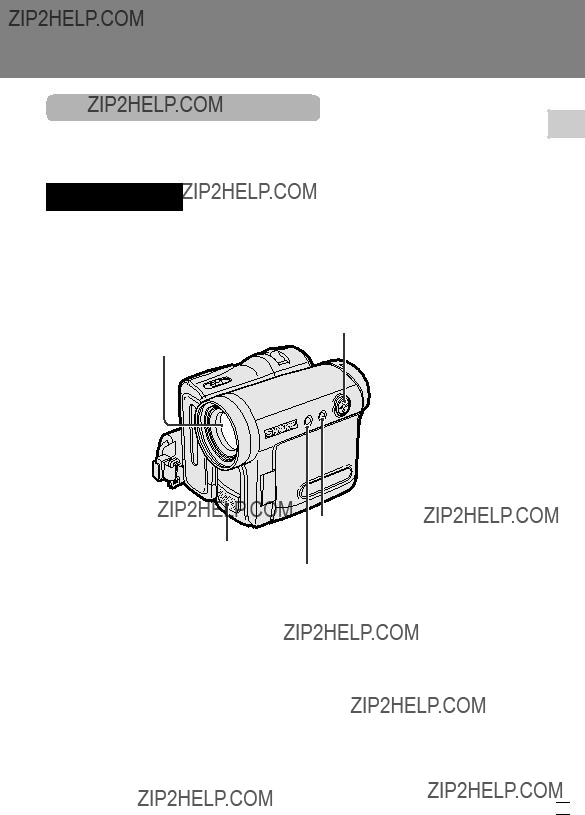
Operation References
Part Names
For details on the use of each part, refer to the page number indicated in parentheses.
Front view
Operation button (p. 28)
Zoom lens
References Operation
Monaural microphone
DISPLAY/MODE SET button (p. 28)/ LCD LAMP button (p. 22)
MENU button (p. 29)
1 


Operation References
Operation References
Left view
DV terminal (pp. 64, 66)
LCD monitor (p. 18)
DC IN jack (pp. 7, 8)
AV terminal
Terminal cover (pp. 27, 61, 62, 66)
(pp. 27, 61, 62, 64, 66)
Lithium battery cover (p. 10)
Dioptre adjustment dial (p. 17)
Tripod socket* 

Battery release (pp. 6, 10)
* When attaching a tripod with a guide pin, do not attach the pin to the bottom of the camcorder.

 2
2

Right view
Window cleaning cover (p. 73)
Viewfinder (pp. 16, 17)
STANDBY indicator (p. 22)
References Operation
Record Start/Stop button (p. 20)
Power switch (v Camera Hand strap (p. 15) Recording mode/w Playback
mode select switch) (pp. 20, 25)
Cassette holder (p. 9)
Cassette compartment door release (p. 9)
Cassette compartment door (p. 9)
3 


Operation References
Warning Indicators
If a warning indicator appears on the screen, follow the specified instructions.
Operation References
Note:
??? Nindicates a flashing display.

 4
4
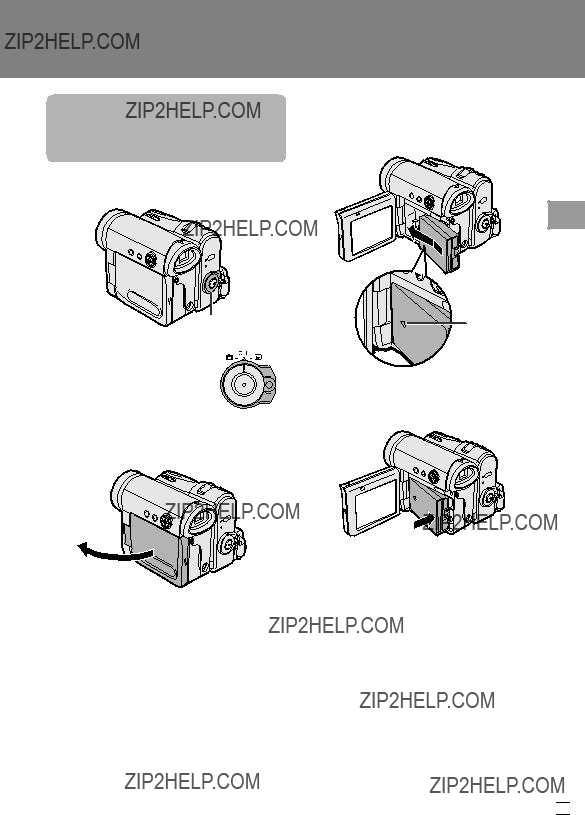
Preparation
Attaching and
Removing the Battery
Pack
Attaching
Power switch
1 Make sure that the Power switch is set to OFF.
2 Open the LCD monitor to a 90?? angle to the camcorder body.
3 Slide the battery pack in the direction of the arrow with the ???m??? mark facing out.
Preparation
???m??? mark
4 Push the battery pack in the direction of the arrow until it clicks.
90??
5 

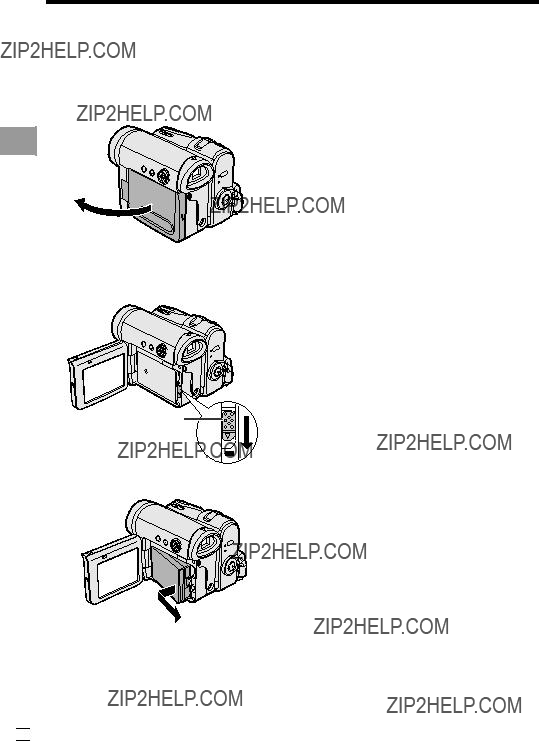
Preparation
Preparation
Removing
1 Make sure that the Power switch is set to OFF, then open the LCD monitor to a 90?? angle to the camcorder body.
90??
2 Slide the battery release in the direction of the arrow.
Notes:
???BEFORE REMOVING THE BATTERY PACK,
ALWAYS STOP RECORDING OR PLAY-
BACK AND TURN THE POWER OFF.
Removing the battery pack while shooting or during playback may damage the tape by causing it to wrap around the video head drum.
???Remove the battery pack from the camcorder if you will not use the camcorder for a long period of time.
???Make sure that the battery pack is firmly attached during operation. If it is not, the battery pack may come off or camcorder operation may fail because of the poor contact pressure.
???To prevent damage to the battery pack when removing, be sure to firmly hold the battery pack while pressing the release.
???Use only SHARP model
???Before closing the LCD monitor, make sure the battery pack is properly attached to the camcorder, otherwise the monitor may be damaged.
Battery release
3 Take the battery pack out.

 6
6

Charging the Battery
Pack
1 Attach the battery pack to the camcorder, and make sure that the Power switch is set to OFF.
2 Connect the supplied power cord to the AC power socket on the AC adapter, and insert the AC plug into a power outlet.
AC power socket
To power outlet
3 Insert the DC plug into the DC IN jack of the camcorder.
???The POWER/CHARGE (RED) indicator lights up red.
POWER/CHARGE (RED) indicator
DC IN jack
DC plug
???The POWER/CHARGE (RED) indicator turns off when the battery is charged.
4 Remove the DC plug from the DC IN jack, then remove the AC adapter from the power outlet.
Charging time and maximum continuous recording and playback times in Tape modes
???The chart specifies the approximate times in minutes.
Notes:
???Charge the battery pack between 10??C and 30??C. The battery pack may not charge properly at temperatures too low or too high.
???The battery pack and AC adapter become warm during charging. This is not a malfunction.
???Using the zoom (see page 21) and other functions or turning the power on and off frequently will increase power consump- tion. This may result in a decrease in the actual recording time compared to the maximum continuous recording time listed above.
???The charging time and recording time may vary depending on the ambient tempera- ture and the condition of the battery pack.
???See pages 72 and 73 for more information on using the battery pack.
???Charge only SHARP model
???When attaching the supplied audio/video/S- video cable, remove the DC plug, open the terminal cover and connect it.
Preparation
7 


Preparation
Preparation
Powering the Camcorder from an AC Outlet
You can also power the camcorder from a power outlet by using the supplied AC adapter.
Note:
???The supplied AC adapter is specially designed for use with this camcorder, and should not be used as a power supply for other camcorders.
1 Make sure that the Power switch is set to OFF.
2 Connect the supplied power cord to the AC power socket on the AC adapter, and insert the AC plug into a power outlet.
4 Hold down the Lock button and set the Power switch to v or w.
???The POWER/CHARGE (RED) indicator lights up green.
Notes:
???BEFORE REMOVING THE DC PLUG,
ALWAYS STOP RECORDING OR PLAY-
BACK AND TURN THE POWER OFF.
Removing the DC plug while shooting or during playback may damage the tape by causing it to wrap around the video head drum.
???Disconnect the AC adapter from the camcorder if you will not use the camcorder for a long period of time.
AC power socket
To power outlet
3 Insert the DC plug into the DC IN jack of the camcorder.
POWER/CHARGE (RED) indicator
DC IN jack
DC plug

 8
8

Inserting and
Removing a Cassette
Inserting
1 Attach the power source to the camcorder, then slide and hold the cassette compartment door release as you open the cassette compart- ment door.
???After confirmation sound, the cassette holder extends and opens automatically.
Cassette compartment door release
2 Insert a commercially available Mini DV cassette fully with the window facing outwards, and with the erasure protect tab facing upwards.
Erasure protect tab
SAVE
REC
3 Press the ???PUSH??? mark gently until the cassette holder clicks into place.
??? The cassette holder retracts automatically.
4 Wait for the cassette holder to fully retract. Close the compartment door by pressing its centre until it clicks into place.
Removing
Perform step 1 above, then take out the cassette.
Notes:
???Do not try to close the cassette compartment door while the cassette holder is extending or retracting.
???Be careful not to get your fingers caught in the cassette holder.
???Do not apply force to the cassette holder except when pressing the ???PUSH??? mark to close it.
???Do not tilt the camcorder or hold it upside down when you are inserting or removing a cassette. It may damage the tape.
???Remove the cassette if you will not use the camcorder for a long period of time.
???If you do not correctly close the cassette holder in step 3, the cassette protection mechanism of the camcorder might eject the cassette. If this happens, repeat the insertion procedure.
???Do not attempt to pick up the camcorder by the cassette compartment door.
???If the battery power is too low, you may not be able to eject the cassette. Replace the battery pack with a fully charged one.
???You can only use Mini DV cassettes. Large DV cassettes cannot be used. Be sure to use Mini DV cassettes with the imark.
???See page 71 for more information on the video cassette tapes intended for use with this camcorder.
Preparation

Preparation
Preparation
Installing the Lithium
Batteries
Installing the Memory Battery
The supplied CR1216 type lithium battery is used to store the memory of the date and time settings.
1
2
3 Slide the battery release in the direction of the arrow, then take the battery pack out.
5 Insert the CR1216 type lithium battery into the compartment with the Hside of the battery facing out.
CR1216 type lithium battery
6 Close the lithium battery cover firmly until it clicks into place.
Removing the Memory
Battery
Perform steps 1 to 4 above, then lift out the battery by using a pointed object such as the tip of a ballpoint pen.
Battery release
4 Pull out the lithium battery cover in the direction of the arrow.
Lithium battery cover

 10
10

Installing the Battery to Remote Control (Not sup- plied)
The remote control (RRMCGA237WJSA) is not supplied with this camcorder. Contact the nearest SHARP service centre or your dealer for purchasing as specified part.
The CR2032 type lithium battery is used to power the remote control unit.
1 Insert a pointed object such as the tip of a ballpoint pen to open the battery holder.
2 Place the CR2032 type lithium battery on the battery holder with the Hside facing down.
CR2032 type lithium battery
3 Close the battery holder until it clicks.
Notes on the Use of the Lithium Battery
CAUTION: Danger of explosion if battery is incorrectly replaced. For camcorder, replace only with same or equivalent type CR1216, for remote control unit, replace only with same or equivalent type CR2032, both recom- mended by the equipment manufac- turer.
XKEEP THIS BATTERY
AWAY FROM CHILDREN. IF SWAL-
LOWED, CONSULT A PHYSICIAN
IMMEDIATELY FOR EMERGENCY
TREATMENT.
ZBATTERY MAY EXPLODE
IF MISUSED OR INSTALLED WITH
POLARITY REVERSED. DO NOT
RECHARGE, DISASSEMBLE OR
DISPOSE OF IN FIRE.
???Do not
???Should the lithium battery leak, wipe the battery compartment clean, and then insert a new battery.
???The lithium batteries will last about one year under normal usage.
Preparation
11 


Preparation
Preparation
Setting the Date and
Time
Example: Setting the date to 2 June 2005 (2. 6. 2005) and the time to 10:30 am (10:30).
Operation button
Power switch
MENU button
Note:
???Before performing the steps below, make sure that the CR1216 type lithium battery has been installed (see page 10).
???The example screens shown are for Camera mode.
1 Hold down the Lock button and set the Power switch to v or
w.
Lock button
2 Press the MENU button to display the menu screen.
3 Press the centre of the Operation button.
4 Press m or l to select ???2??? (day), then press the centre of the Operation button.
5 Press m or l to select ???6??? (month), then press the centre of the Operation button.
6 Press m or l to select ???2005??? (year), then press the centre of the Operation button.
7 Press m or l to select ???10??? (hour), then press the centre of the Operation button.

 12
12

8 Press m or l to select ???30??? (minute), then press the centre of the Operation button.
???The internal clock now starts operating with the seconds display.
9 Press the MENU button to turn off the menu screen.
Note:
???If the date and time have been set, the SETTING 1 screen (T) appears in step 2. Select ???SETTING??? in the OTHERS 2 screen (~) using the Operation button.
Changing to the
1 After performing step 8 above, press l or m to select ???12H/24H???, then press the centre of the Operation button.
D A T E D I S P . 1 2 H
S E T T I NG
R E T U R N
2 Press l or m to select ???12H???, then press the centre of the Operation button.
3 Press the MENU button to turn off the menu screen.
Notes:
???The date and time, once set, are internally recorded even when not displayed on the screen.
???The menu screen automatically turns off if no settings are made within 5 minutes.
Preparation
13 


Preparation
Using the Lens Cap
Attach the strap of the lens cap to the hand strap as shown below.
When recording, remove the lens cap and attach the lens cap cord to the fastener so that the cap will not get in the way.
Preparation
When attaching or removing the lens cap, grasp the indents on both sides of the cap.
Fastener
Note:
???Always attach the lens cap over the lens when not using the camcorder.
Indents

 14
14
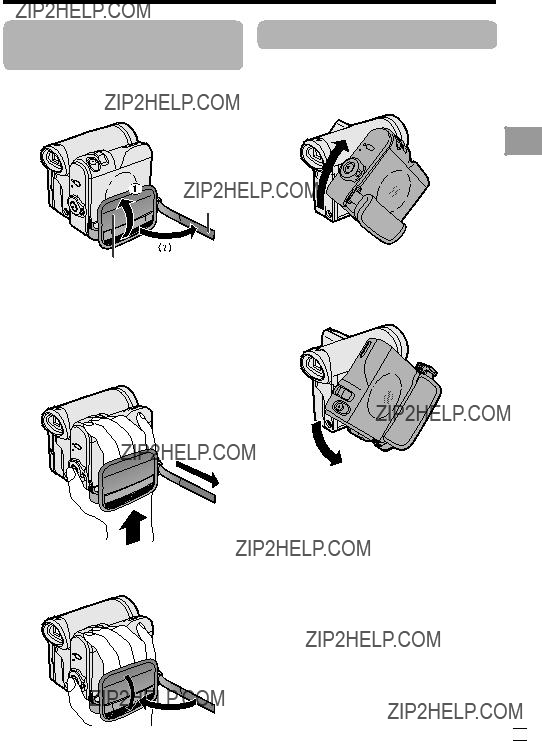
Adjusting the Hand
Strap
1 Open the hand strap flap (1) and grip strap (2).
Grip strap
Hand strap flap
Using the Grip
Rotate the grip 135?? forward or 105?? downward so that you can record images easily from high or low angle (see page 19).
135??
Preparation
2 Loosen the grip strap, pass your right hand through the hand strap, and put your thumb close to the Record Start/ Stop button and your index finger on the Power Zoom control. Then, pull the grip strap tight until it fits snugly.
105??
Note:
??? The grip cannot rotate when a tripod is attached.
3 Seal the Velcro?? fasteners of the grip strap and the hand strap flap.
15 


Preparation
Detaching the Lens
Hood
Before using a commercially available conversion lens, detach the lens hood as shown below.
Using the Viewfinder
You can record the subject using the electronic viewfinder. You can also watch playback through the viewfinder.
Viewfinder
Preparation
Power switch
1 Pull out the viewfinder completely.
Note:
???You cannot attach the supplied lens hood or lens cap to a conversion lens.
2 Hold down the Lock button and set the Power switch to v or w.
Lock button

 16
16

Closing the viewfinder
Push in the viewfinder completely.
Notes:
???Do not use excessive force when moving the viewfinder.
???Do not pick up the camcorder by the viewfinder.
???The viewfinder automatically turns off when the LCD monitor is opened. If the vertical rotation of the monitor is 180?? when Camera mode, however, the viewfinder is on and the subject is displayed both in the viewfinder and on the monitor (see page 38).
???You can adjust the settings on the MENU screen through the viewfinder by using the Operation button (see page 28 for use of the Operation button).
???Be sure to close the viewfinder after use.
Adjusting the dioptre
Adjust the dioptre according to your eyesight when the picture in the viewfinder or the characters on the
1 Pull out the viewfinder completely.
2 Hold down the Lock button and set the Power switch to v.
3 While looking through the viewfinder, turn the dioptre adjustment dial until the indicators in the viewfinder are clearly visible.
Dioptre adjustment dial
Note:
??? For cleaning the viewfinder, see page 73.
Preparation
17 


Preparation
Using the LCD
Monitor
You can use the LCD monitor to play back recordings that you have made or to watch the subject during recording.
???You can also fold the LCD monitor into the camcorder with the screen facing out for watching playback on the monitor.
Preparation
 Power switch LCD monitor
Power switch LCD monitor
1 Open the LCD monitor to a 90?? angle to the camcorder body.
3 Hold down the Lock
Note:
???Battery consumption is larger when the LCD monitor is opened. Use the viewfinder instead of the LCD monitor when you want to save the battery power.
90??
2 Adjust the LCD monitor to an angle that allow easy viewing of the on- screen picture.
???The LCD monitor rotates 270?? vertically.
180??
90??
Note: Do not try to rotate the LCD monitor vertically until the monitor is completely opened.
Closing the LCD monitor
Return the LCD monitor to the vertical 90?? position with the screen facing in, and fold it into the camcorder into place.
Notes:
???Do not use excessive force when moving the LCD monitor.
???When closing the LCD monitor, do not tilt it; otherwise the monitor may not close properly and may become damaged.
???Do not pick up the camcorder by the LCD monitor.
???Do not place the camcorder with the LCD monitor screen facing down.
???Close the LCD monitor completely with the screen facing in when not in use.
???Before closing the LCD monitor, make sure the battery pack is properly attached to the camcorder, otherwise the monitor may be damaged.
???When carrying the camcorder in a bag, for example, close the LCD monitor with the screen facing in.

 18
18
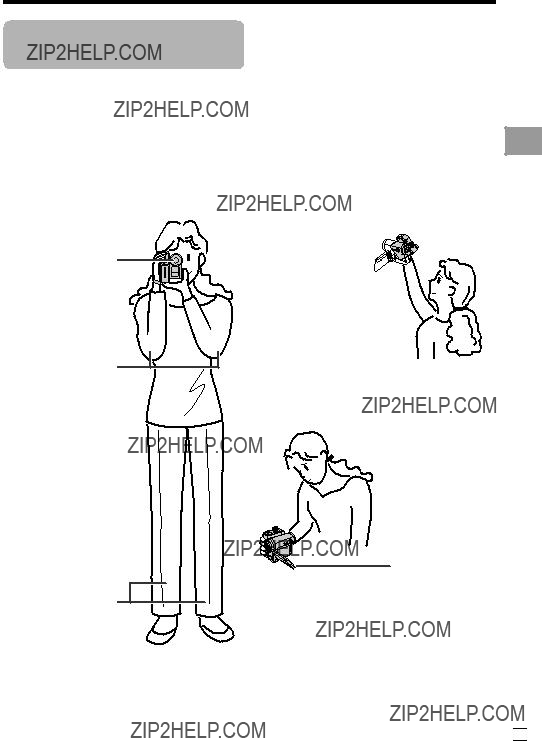
Tips on Recording
Positions
To create images that are easy to watch during playback, try to record with an upright posture and steady hands to prevent a shaky image.
Holding the camcorder
Put your right hand through the hand strap, and place your left hand under the camcorder for support.
Preparation
Place the viewfinder eyecup firmly against your eye.
Place your elbows against your sides.
Balance your weight on both legs.
Note:
Turn the LCD 
 monitor so that the
monitor so that the
screen faces downward.
Shooting from a low angle
Turn the LCD monitor so that the screen faces upward.
???Take care not to touch the microphone with your fingers during recording. It will cause noise on the audio track.
19 


Basic Operations
Camera Recording
Easy Camera
Recording in Full
Auto Mode
???Before you start recording, perform the operations described on pages 5 through 19 to prepare your camcorder for recording.
2 Hold down the Lock button and set the Power switch to v.
???The picture from the lens now displays and the POWER/CHARGE (RED) indicator lights up green.
???The camcorder is now ready to record (Recording Standby mode).
POWER/CHARGE (RED) indicator
P A U S E
A U T O
Lock button
Note:
???If ???AUTO??? is not displayed at this time, set the camcorder to Full Auto mode (see page 54).
3 Press the Record Start/Stop button to begin recording.
R E C
Note:
???Before recording an important scene, please perform the recording test, then playback to check if the scene was recorded properly. If noise occurs, use a commercially available cleaning tape to clean the video heads (see page viii).
Maximum continuous recording and actual recording times
???The chart specifies the approximate times in minutes.
Note:
???Using the zoom (see page 21) and other functions or turning the power on and off frequently will increase power consump- tion. This may result in a decrease in the actual recording time compared to the maximum continuous recording time listed above.

 20
20

To pause recording
Press the Record Start/Stop button again. Recording pauses, and the camcorder enters Recording Standby mode.
P A U S E
Zooming
Zooming allows you to move visually closer to or further from a subject without physi- cally changing your position.
When using the optical zoom, you can enlarge the subject up to 10K.
Zooming in (when you want to centre attention on the subject)
To turn the power off
Set the Power switch to OFF without pressing the Lock button.
Remaining in Recording Standby mode for 5 minutes
If the camcorder remains in Recording Standby mode over 5 minutes, the camcorder automatically enters stop mode to protect the tape from damage.
???To resume Recording Standby mode from stop mode, press the STANDBY button (see page 22).
???To resume recording from stop mode directly, press the Record Start/Stop button. However, it may need several seconds to resume recording after pressing the Record Start/Stop button.
???The zoom range indicator shows you the current zoom setting.
???The zoom speed depends on how far you push the Power Zoom control.
Notes:
???The camcorder is unable to focus when zooming in on subjects closer than 1.5 m.
???See page 30 for how to use the digital zoom.
21

Basic Operations
Camera Recording
Power Standby Mode
Power Standby mode allows you to prevent accidental recording by locking all operations except cancelling the mode.
To resume operation
Press the STANDBY button again to return to the Recording Standby mode.
???It takes about 2 seconds to be able to start recording.
Notes:
???Power Standby will cancel and the STANDBY indicator will turn off in these situations below:
???When the camcorder remains in Power Standby mode for more than 5 minutes
???When the camcorder is set to Playback mode
???When removing the battery pack
???When removing a cassette
???The camcorder will enter stop mode automati- cally 5 minutes after setting Power Standby mode if it remains in Recording Standby mode after cancelling Power Standby mode.
???When Power Standby mode, for example, is cancelled after 3 minutes, the
camcorder will enter stop mode if
22 recording is not started within 2 minutes.
Turning on/off the
Backlight
You can see the
LCD LAMP button
Hold down the LCD LAMP button for more than 2 seconds to turn off the backlight.
??? H will flash for 2 seconds, then lights up.
To turn on the backlight
Hold down the LCD LAMP button for more than 2 seconds.
Note:
???The backlight off mode will cancel when you close the LCD monitor.

Auto Focus
The camcorder is preset to Auto Focus mode, which is designed to focus on most types of subjects. In Auto Focus mode, the camcorder automatically focuses on the subject in the centre of the scene. Always keep the subject in the centre of the scene.
Notes:
???If no subject is in the centre of the scene, the focus area will expand and the subject nearest the centre will be focused on.
???Auto Focus may not work in the situations described on page 47. In these situations, use the manual focus function.
???The camcorder may not be able to focus correctly if the subject is closer than approximately 1.5 m. Set the zoom control to wide angle, and try refocusing again.
???If the lens is dirty or fogged, the camcorder may not be able to focus correctly.
Macro Shots
This camcorder lets you shoot
Note:
???When you are recording a macro shot, be sure that the subject receives sufficient illumination.
Remaining Recording
Time Display
When the camcorder is recording, an on- screen indicator displays the approximate remaining tape time in minutes.
Remaining
3 0 minrecording time indicator
Notes:
???The remaining recording time indicator appears when the
???The remaining recording time indicator appears 10 seconds after pressing the Record Start/Stop button to begin recording.
???The remaining recording time indicator only shows the approximate time left. Also, it varies slightly depending on the length of the tape used. (This function is based on the DVM60 tape standard.)
When the remaining recording time reaches 1 minute, a warning indicator will appear. Prepare a new cassette.
Operations Basic
23

Basic Operations
Camera Recording
Basic Operations
When using the camcorder with the battery pack as the power source, the remaining battery power indicator is displayed. If the battery power becomes very low, a warning indicator appears. Replace the battery pack.
Notes:
???The remaining battery power indicator appears when the
???Use the remaining battery power indicator only as an approximate indication.
???The remaining battery power indicator may change to either a higher or lower level if you set the Power switch to OFF and then back to vor w.
???In cold environments, the red remaining battery power indicator may appear sooner.
???Use of the zoom functions when the warning indicator is displayed may cause the camcorder to suddenly lose power.
When the camcorder operates with the battery pack, the battery usage indicator appears beside the remaining battery power indicator.
Battery usage indicator for the battery pack attached to the camcorder
Battery usage indicator for the optional external battery with hand strap
When both indicators appear, the camcorder consumes power from both battery packs.
When one indicator appears, it consumes power from the indicated battery pack.

 24
24

Basic Operations
Playback
Playback
The LCD monitor screen functions as a handy playback monitor. Nothing needs to be connected, allowing instant
Power switch
Operation button
1 Hold down the Lock button and set the Power switch to w.
Lock button
2 Press j (or k) on the Operation button to rewind (or fast forward) the tape to the desired point.
Note:
???If you press the Record Start/Stop button in Playback mode, the ???g??? mark appears and the camcorder enters Recording Standby mode. If you do not intend to record, press l to turn the ???g??? mark off, then press m to begin playback. This will ensure your previous recording is not erased (see pages
To stop playback
Press l.
To turn the power off
Set the Power switch to OFF without pressing the Lock button.
Notes:
???The tape automatically rewinds when playback reaches the end of the tape.
???When selecting ???5 MIN??? or ???10 MIN??? in power save mode and remaining in stop mode without any operation for 5 or 10 minutes, the camcorder will turn off automatically.
Operations Basic
3 Press m to begin playback.
Watching the playback in the viewfinder
You can also watch the playback in the viewfinder by closing the LCD monitor with the screen facing in. You cannot monitor the sound through the speaker when watching the playback in the viewfinder.
25

Basic Operations
Playback
When the camcorder is in Playback mode, push the Volume control to the L or + side to increase (1) or decrease (2) the volume.
The volume level indicator will appear on the LCD screen during adjustment only. Once the Volume control is released, the volume level indicator will disappear shortly afterwards.
Still
The still function allows you to pause playback.
During playback, press m on the Operation button.
To return to normal playback, press m again.
Notes:
???The sound is off in Still mode.
???To protect the tape, the camcorder automati- cally returns to normal playback if it is left in Still mode for more than 5 minutes.
The video search function makes it easy to search for a desired scene on the tape.
Searching for a Scene Near the Current Tape Position
1 During playback, press k (or j) on the Operation button.
???The playback picture fast forwards (or reverses).
2 When you find the scene, press m to return to normal playback.
Searching for a Scene Far from the Current Tape Posi- tion
1 During fast forward (or rewind), press and hold k (or j) on the Operation button.
???The fast forward (or rewind) picture displays.
2 If the scene is still rather far from the current tape position, release the Operation button to normal fast forward (or rewind).
3 Repeat steps 1 and 2 above until you find the scene.
4 Press m to begin normal playback.
Notes:
???The sound is off during search.
???You may experience picture noise during search. This is not a malfunction.

 26
26

Watching Playback on a TV
You can connect the camcorder to a TV to allow a larger audience to enjoy playback.
1 Open the terminal cover on the camcorder (see page 2).
Terminal cover 
2 Connect the camcorder to your TV (or VCR) with the supplied audio/video/S- video cable, as shown.
TV or VCR
VIDEO
Black: To
Yellow: To video input jack
White: To audio input (L) jack
Red: To audio input (R) jack

To AV terminal
 : The arrow shows the signal flow.
: The arrow shows the signal flow.
Note:
???Check that the camcorder, TV, VCR and other equipment to be used are turned off before making any connections.
Picture noise or malfunction may occur if any of the above is left on while making a connection.
3 Turn on the TV and set it to the ???AV??? or ???VIDEO??? channel. (See the operation manual of your TV.)
???When connecting to a TV via a VCR, turn on the VCR and set it to the ???AV??? or ???LINE??? input channel. Operate the TV as you normally do to view the signal from the VCR. (See the operation manuals of your TV and VCR.)
4 Set the Power switch on the camcorder to w, and begin playback (see page 25).
Notes:
???If your TV or VCR has only one audio input jack, use the white plug for the audio connection on the TV or VCR.
???If your TV or VCR has an
???Close the terminal cover after use.
About the
Operations Basic
27
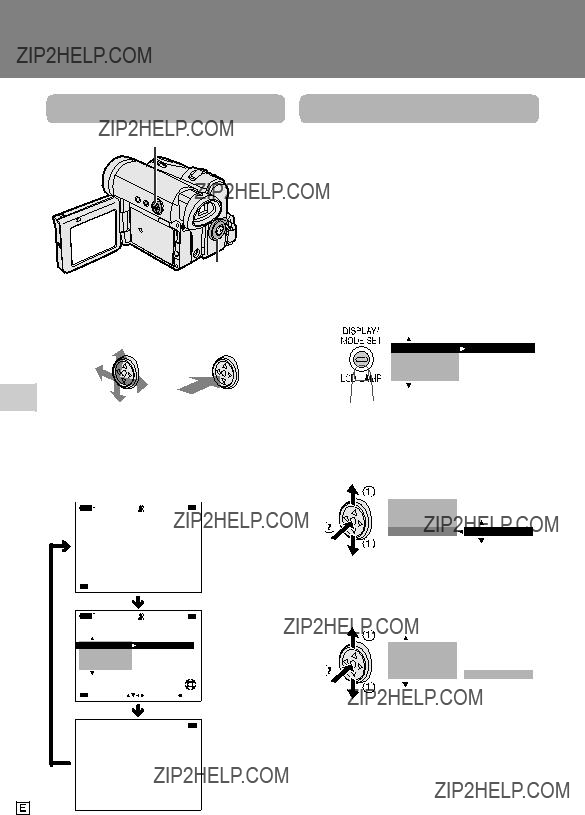
Useful Features
Control Buttons
Operation button
 Power switch DISPLAY/MODE SET button
Power switch DISPLAY/MODE SET button
Operation button
Use the Operation button to select and set the desired setting.
Using the Mode Screens
In the mode screens, you can adjust the camcorder settings by using the Operation button.
1 Hold down the Lock button and set the Power switch to v or w.
???See pages 80 and 81 for the mode items you can select in each mode.
???Steps 2 to 4 show how to change the SCENE MENU setting in Camera mode.
2 Press the DISPLAY/MODE SET button until the mode screen appears.
M A N U A L S E T E X E C U T E
F O C U S
A U T O F O C U S
B L C / G A I N
28
3 Press lor mon the Operation button to select the desired mode item (SCENE MENU), then press the centre of the Operation button.
Example
A U T O F O C U S
B L C / G A I N
F A D E
S C E N E M E N U O F F
4 Press lor mto select the desired mode setting (DUSK), then press the centre of the Operation button.
Example
A U T O F O C U S
B L C / G A I N
F A D E
S C E N E M E N U DU S K
DU S K
To turn off the mode screen
Press the DISPLAY/MODE SET button.
Note:
??? Items that are not selectable are greyed out.

Using the Menu Screens
Use the menu screens to adjust the various camcorder settings.
Operation button
4 Press lor mto select the desired menu item (DGTL ZOOM), then press the centre of the Operation button.
Example
???You can press k, instead of the centre of the Operation button.
MENU button
Power switch
5 Press lor mto select the desired
1 Hold down the Lock button and set the Power switch to vor w.
???See pages 80 and 81 for the menu items you can select in each mode.
???Steps 2 to 5 show how to change the DGTL ZOOM menu setting in Camera mode.
2 Press the MENU button to display the menu screen.
Example
S E T T I N G 1
R E T URN
Note:
???The menu screen does not appear during recording.
3 Press lor mon the Operation button to select the desired menu screen (T), then press the centre of the Operation button.
Example
S E T T I N G 1
 QK. RE TURN S T ART
QK. RE TURN S T ART
R E T URN
???You can press k, instead of the centre of Operation button.
menu setting (40), then press the centre of the Operation button.
DG T L ZOOM 4 0
???You can press j, instead of the centre of the Operation button.
???To adjust another menu item, press lor mto select ???RETURN??? and press the centre of the Operation button, then perform steps 3 to 5.
To turn off the menu screen
Press the MENU button.
Notes:
???Certain menu items are common in both Camera and Playback modes. If the BEEP menu item, for example, is set to ???OFF??? in Camera mode, it will be automatically set to ???OFF??? in Playback mode.
???The menu screen automatically turns off if no settings are made within 5 minutes.
???Items that are not selectable are greyed out.
Features Useful
29 


Useful Features
Camera Recording
Setting the Digital
Zoom
You can select three different zoom ranges:
Notes:
???The digital zoom is in addition to the optical zoom giving a combined maximum zoom range of
???As the image is enlarged digitally, the picture quality decreases when higher digital zoom settings are used.
1
The ???D??? digital zoom indicator is displayed during digital zooming.
To use optical zoom only
Select ???OFF??? in step 4 above.
4 Press lor mto select ???40??? or ???500???, then press the centre of the Operation button.
DG T L ZOOM 4 0
5 Press the MENU button to turn off the menu screen.

 30
30

Backlight
Compensation (BLC)
When the subject is backlit, the image will appear dark if it is recorded normally. Use the backlight compensation (BLC) function to brighten the entire screen.
1 In Camera mode, press the DISPLAY/ MODE SET button until the mode screen appears.
M A N U A L S E T E X E C U T E
F O C U S
A U T O F O C U S
B L C / G A I N
2 Press lor mon the Operation button to select ???BLC/GAIN???, then press the centre of the Operation button.
3 Press lor mto select ???ON x???, then press the centre of the Operation button.
4 Press the DISPLAY/MODE SET button to turn off the mode screen.
??????x??? appears when
P A U S E
A U T O
3 0 min
To cancel the backlight compensa- tion function
Select ???OFF??? in step 3 above.
Features Useful
31 


Useful Features
Camera Recording
When you are recording in a dark or poorly illuminated location, ???LIGHT??? is displayed on the screen. Use the
Note:
???At locations where lighting is adequate, ???LIGHT??? will not appear. The
1 In Camera mode, press the DISPLAY/ MODE SET button until the mode screen appears.
To cancel the
Select ???OFF??? in step 3 above.
Notes:
???You may experience some picture noise in
???When the eindicator appears, you may get a shadow image behind a subject that is moving around a lot.
???Fine brightness adjustments are possible when using manual iris (see page 51).
???The eindicator will disappear and
Useful Features
M A N U A L S E T E X E C U T E
F O C U S
A U T O F O C U S
B L C / G A I N
2 Press lor mon the Operation button to select ???BLC/GAIN???, then press the centre of the Operation button.
3 Press lor mto select ???ON e???, then press the centre of the Operation button.
4 Press the DISPLAY/MODE SET button to turn off the mode screen.
??????e??? appears when
P A U S E
A U T O
3 0 min

 32
32

Fade In and Fade Out
The fade function allows you to gradually bring the image and sound in or out at the beginning or end of a scene for creating scene transitions. This is especially effective in creating a dramatic change in scenery.
Operation button
Record Start/Stop DISPLAY/MODE button
SET button
Fade in
4 Press the DISPLAY/MODE SET button until
5 Press the Record Start/Stop button to begin recording.
???The picture turns white, and the image and sound fade in.
R E C
F A D E I N
A U T O
3 0 min
6 Press the Record Start/Stop button at the point where you wish to stop recording.
???The image and sound fade out as the picture gradually turns white. The camcorder then returns to Recording Standby mode.
Useful
Fade out
Using
1 In Camera mode, press the DISPLAY/ MODE SET button until the mode screen appears.
2 Press l or m on the Operation button to select ???FADE???, then press the centre of the Operation button.
F O C U S
A U T O F O C U S
B L C / G A I N
3 Press l or m to select ???ON???, then press the centre of the Operation button.
R E C
F A D E O U T
A U T O
2 7min
To cancel Fade mode
Select ???OFF??? in step 3 above.
To use Fade Out only
1 During camera recording, press the DISPLAY/MODE SET button until the mode screen appears.
2 Perform steps 2 and 3 in ???Using???.
3 Press the Record Start/Stop button at the point where you wish to stop recording.
Note:
???Fade mode automatically cancels after Fade Out.
Features
33 


Useful Features
Camera Recording
If while playing back your tape you want to quickly return to the last recorded scene and start recording again, use the quick return function.
1 In Recording Standby mode, press the MENU button to display the menu screen.
2 Press l or m on the Operation button to select T, then press the centre of the Operation button.
3 Press l or m to select ???QK. RETURN???, then press the centre of the Operation button.
Notes:
???To cancel the quick return function while ???SEARCH??? is flashing, press the centre of Operation button twice.
???Quick return will not work if you remove the cassette and reload it after recording or if nothing has been recorded since loading.
???When the camcorder remains in Recording Standby mode for more than 5 minutes and enters stop mode, quick return will not work.
Useful Features
R E T URN
4 Press l or m to select ???START???, then press the centre of the Operation button.
??????SEARCH??? flashes, and the tape begins fast forwarding or rewinding to the end of the last recorded scene.
S E A R C H
???When the tape reaches the end of the last recorded scene, ???FINISHED??? is displayed, and the camcorder enters Recording Standby mode.

 34
34

Edit Search
The edit search function lets you search, without switching from Camera mode to Playback mode, for the point on the tape where you wish to start recording next.
Operation button
1 In Recording Standby mode, press and hold down j (reverse edit search) or k (forward edit search) on the Operation button.
2 When you find the point where you want to begin recording, release the button.
Notes:
???The sound is off during search.
???Forward edit search is performed at the same speed as normal playback, and reverse edit search at 6.5 times the normal playback.
???You may experience picture noise during reverse edit search.
???When the camcorder remains in Recording Standby mode for more than 5 minutes and enters stop mode, edit search will not work.
Still Recording
You can record continuous still images of subjects.
1 In Recording Standby mode, press the PHOTO 
 button fully.
button fully.
???A still image of the subject is displayed.
2 Press the Record Start/
Stop button.
??? The still image of the subject will be recorded.
???During still recording,
???RECORDED ON TAPE??? appears on the screen.
To pause recording
Press the Record Start/Stop button.
To cancel the still image
Press the PHOTO button fully.
Notes:
???Still Recording can also be used during recording by pressing the PHOTO button fully.
???The picture quality in Still Recording function will be slightly lower than normal pictures.
Features Useful
35 


Useful Features
Camera Recording
Useful Features
Digital Image
Stabilization (DIS)
The digital image stabilization (DIS) function al- lows you to stabilize the image by electronically compensating for relatively minor image shak- ing that is often annoying in
1
2 Press l or m on the Operation button to select Y, then press the centre of the Operation button.
3 Press l or m to select ???DIS???, then press the centre of the Operation button.
 A U D I O MO D E O F F
A U D I O MO D E O F F
W I N D
R E T U R N
4 Press lor mto select ???ON???, then press the centre of the Operation button.
D I SON
5 Press the MENU button to turn off the menu screen.
???The DIS indicator only appears when the
DIS indicator
Wide Mode
The wide screen function lets you record scenes with the
1 In Camera mode, press the MENU button to display the menu screen.
2 Press l or m on the Operation button to select T, then press the centre of the Operation button.
3 Press l or m to select ???WIDE MODE???, then press the centre of the Operation button.
R E T U R N
P A U S E
To cancel DIS function
Select ???OFF??? in step 4 above. The z indicator will disappear.
Notes:
???The DIS function cannot compensate for excessive image shaking.
???When image shaking does not occur (e.g. when using the camcorder on a tripod), turn off the DIS function. The picture will appear more natural when the DIS function is off.
4 Press l or m to select ???ON???, then press the centre of the Operation button.
???The picture is displayed with the top and bottom portions masked.
WIDE MODE ON
5 Press the MENU button to turn off the menu screen.
To return to normal screen
Select ???OFF??? in step 4 above.

 36
36

Power save mode will turn off the camcorder automatically to save battery power when the camcorder is not in use for 5 or 10 minutes.
Note:
???To resume recording or playback, set the Power switch to OFF, then back to v or w.
???The example screens shown are for Camera mode.
1 Turn on the camcorder, then press the MENU button to display the menu screen.
2 Press l or m on the Operation button to select ~, then press the centre of the Operation button.
3 Press l or m to select ???POWER SAVE???, then press the centre of the Operation button.
O T H E R S 2
POW E R S A V E O F F
T I ME CO D E 5 M I N
4 Press l or m to select ???5 MIN??? or ???10 MIN???, then press the centre of the Operation button.
P OWE R S A V E 5 M I N
5 Press the MENU button to turn off the menu screen.
To cancel the power save mode
Select ???OFF??? in step 4 above.
Notes:
???The camcorder will not turn off when recording or playing back. It will also not turn off when inputting AV or DV for
???The camcorder will turn off prior to Power Standby mode.
The windbreak function allows you to reduce annoying noise from strong winds when recording.
1 In Camera mode, press the MENU button to display the menu screen.
2 Press l or m on the Operation button to select Y, then press the centre of the Operation button.
3 Press l or m to select ???WIND???, then press the centre of the Operation button.
4 Press l or m to select ???ON???, then press the centre of the Operation button.
5 Press the MENU button to turn off the menu screen.
To cancel Windbreak
Select ???OFF??? in step 4 above.
Note:
???Keep the windbreak function off during normal recording. If left on, the recorded audio may sound somewhat muffled when played back.
Features Useful
37 


Useful Features
Camera Recording
If the camcorder is steadied, you can record yourself in the scene by watching yourself on the LCD monitor.
Useful Features
1 Pull out the viewfinder completely. Open the LCD monitor to a 90?? angle to the camcorder body (1), and then rotate it 180?? vertically (2).
3 Begin recording.
Note:
???You can play back images while the monitor is in the self recording position. Set the camcorder to Playback mode.
180??
90??

 38
38

1 Turn the camcorder downward as shown below.
2 Rotate the lens section 105?? vertically as shown below.
105??
4 Set the Power switch to v.
5 Begin recording.
Notes:
???Do not rotate the monitor section to the self recording position during recording or playback.
???During self recording with reversed grip, the mode or menu screen cannot be displayed.
???All of the manual settings are set to AUTO and some other settings will set to OFF in self recording with reversed grip.
???You may experience image noise when using self recording.
???To operate self recording with reversed grip correctly, make sure to turn the grip and the lens section so that the Record Start/Stop button and the tripod socket face upward, and the lens faces toward you. The I indicator will appear.
???Be sure that the LCD monitor rotation is exactly 180??, otherwise the image recorded will be rotated 180??
???The viewfinder does not work in self recording with reversed grip.
Features Useful
39 


Useful Features
Camera Recording
Features
Recording in LP (Long
Play Recording) Mode
This camcorder allows you to record in LP (Long Play Recording) mode for approxi- mately 50% more recording time with the same picture quality as that in SP (Standard Play Recording) mode.
1 In Camera mode, press the MENU button to display the menu screen.
2 Press l or m on the Operation button to select T, then press the centre of the Operation button.
3 Press l or m to select ???TAPE SPEED???, then press the centre of the Operation button.
To return to SP mode
Select ???SP??? in step 4 above.
Notes on the use of LP mode
???To record in LP mode, be sure to use a Mini DV cassette labelled for use with LP mode.
???Frozen images,
???Audio dubbing is not possible with LP mode recording.
Useful
4 Press l or m to select ???LP???, then press the centre of the Operation button.
T AP E SP E E D LP
5 Press the MENU button to turn off the menu screen.
???The long play recording mode indicator only appears when the on- screen indicators are turned on.
L P
P A U S E
Long play recording mode indicator

 40
40

Selecting the
Audio Recording
Mode
The camcorder normally records audio in the
1 In Camera mode, press the MENU button to display the menu screen.
2 Press l or m on the Operation button to select Y, then press the centre of the Operation button.
3 Press l or m to select ???AUDIO MODE???, then press the centre of the Operation button.
4 Press l or m to select ???16bit???, then press the centre of the Operation button.
AUD I O MODE 1 6 bit
5 Press the MENU button to turn off the menu screen.
???The
P A U S E 1 6 bit
To return to
Select ???12bit??? in step 4 above.
Note:
???When using Audio Dubbing with
Features Useful
41 


Useful Features
Playback
Useful Features
Using the Remote
Control
(Not Supplied)
The remote control (RRMCGA237WJSA) is not supplied with this camcorder. Contact the nearest SHARP service centre or your dealer for purchasing as specified part.
Activating
???The example screens shown are for Playback mode.
1
2 Press l or m on the Operation button to select Z, then press the centre of the Operation button.
3 Press l or m to select ???REMOTE???, then press the centre of the Operation button.
O T H E R S 1
Operating
Aim the remote control at the remote sensor of the camcorder, and press the control buttons to operate.
Remote sensor
ZOOM (W/T) buttons
PLAY/STILL button
*
4 Press l or m to select ???ON???, then press the centre of the Operation button.
REMO T E ON
5 Press the MENU button to turn off the menu screen.

 42
42
Advance/reverse buttons
* Shift buttons
VOLUME +/L buttons
T/C (Time Code) button
DATE button
STOP button
REW button
Notes:
???Be careful not to expose the remote sensor to direct sunlight or strong interior lighting, as this may prevent the remote control from operating properly.
???Be sure that there are no obstacles between the remote control and the remote sensor.
???The buttons with an asterisk mark (*) do not work with this camcorder.

Selecting the Date
and Time of
Recording Display
Follow the procedure below to select the date, or both the date and time, of recording display on the screen. You can display the date and time during both recording and playback.
???The example screens shown are for Playback mode.
1 Press the MENU button to display the menu screen.
2 Press l or m on the Operation button to select ~, then press the centre of the Operation button.
3 Press l or m to select ???DATE DISP.???, then press the centre of the Operation button.
 T C O U T
T C O U T
1 2 H / 2 4 H
D A T E D I S P . D A T E + T I ME
4 Press l or m to select the desired setting, then press the centre of the Operation button.
DATE D I S P. DA T E
5 Press the MENU button until the date (or date and time) appears.
2 . 6 . 2 0 0 5
 P L A Y
P L A Y  S T O P
S T O P  R EW
R EW  F F
F F
Notes:
???The date (or date and time) appears when the
???Before recording, make sure that the date and time have been correctly set. If they have not been set, the display will be left blank when playing back the recording. (The display will also be left blank for unrecorded or damaged portions of the tape.)
???In Playback mode, the current date and time are displayed when the tape is not being played back.
???You can also press the DATE button on the remote control (not supplied) to display the date (or date and time).
Features Useful
43 


Useful Features
Playback
Picture Effect
Playback
These picture effects let you play back images with a more dramatic effect.
Types
4 Press the DISPLAY/MODE SET button to turn off the mode screen.
To cancel picture effect playback
Select ???OFF??? in step 3 above.
Note:
Useful Features
B/W: The picture is displayed in
SEPIA: The picture is displayed in sepia colour similar to that of an old photograph.
SOLARI: The contrast of the subject is enhanced, creating an unique artistic image.
NEGA: The blacks and whites of the image are reversed and colours of the image are inverted.
1 During playback, press the DISPLAY/ MODE SET button until the mode screen appears.
2 Press l or m on the Operation button to select ???PIC. EFFECT???, then press the centre of the Operation button.
P I C . E F F E C T O F F
O F F
A U D I O D U B
S T R E T C H P B
???Video images in picture effect playback mode cannot be transferred via DV cable to a personal computer.
3 Press l or m to select the desired picture effect, then press the centre of the Operation button.
P I C. E F F E C T B
B W
W

 44
44

Rotate Playback
This function allows you to play back images rotated 180??.
1
2 Press l or m on the Operation button to select V, then press the centre of the Operation button.
3 Press l or m to select ???ROTATE PB???, then press the centre of the Operation button.
???Rotate playback indicator appears. of the Operation button.
R E T U RN
AUDIO1 + 2
RO T A T E P B
Rotate playback indicator
*???ANLGyDGTL??? does not appear with
4 Press m to begin rotate playback.
???The image is rotated 180?? upside down.
To cancel rotate playback
Press the centre of the Operation button in step 4 above.
Notes:
???When executing rotate playback during playback, playback will stop. Press m to begin rotate playback.
???Even if the camcorder is in rotate playback mode, the image output via a DV connection will display as normal playback.
???When you want to display the menu screen during rotate playback, press the centre of the Operation button.
???In rotate playback mode, you cannot perform picture effect playback.
Features Useful
45 


Useful Features
Playback
Features
Stretch Playback
Stretch playback allows you to playback a squeezed image with the wide screen feel of a movie shown in a theatre. Useful when you want to play back images recorded by a camera other than this camcorder in wide mode on a 4:3 TV.
1 In Playback mode, press the DIS- PLAY/MODE SET button until the mode screen appears.
2 Press l or m on the Operation button to select ???STRETCH PB???, then press the centre of the Operation button.
To cancel stretch playback
Press the centre of the Operation button in step 3 above.
Notes:
??????Squeeze??? is an image compression technology. A 16:9 image is compressed and recorded (squeeze recorded) as a 4:3 image.
???In stretch playback mode, you cannot perform picture effect playback.
???When outputting the stretch playback image from the DV terminal, the original image signal will be output.
???When performing stretch playback, the normal recorded image (picture aspect ratio 4:3) will be stretched as shown below.
Useful
P I C . E F F E C T
A U D I O D U B
S T R E T C H P B E X E C U T E
E X E C U T E
???Playback will stop after turning on stretch playback.
3 Press m to begin stretch playback.
AUDIO1 + 2
S T R E T C H P B
C A N C E L
P A U S E S T O P R EW F F
???The picture displays with black bands.

 46
46

Advanced Features
Camera Recording
Manual Focus
Auto Focus may not be able to focus on the subject in the situations shown below. In such situations, set the camcorder to Manual Focus mode and focus manually.
Operation button
Power Zoom control
DISPLAY/MODE SET button
1 In Camera mode, press the DISPLAY/ MODE SET button until the mode screen appears.
2 Press l or m on the Operation button to select ???FOCUS???, then press the centre of the Operation button.
indicators are turned on.
Manual focus indicator
MF
3 0 min
Note:
???When ???MF??? is displayed, you can manually adjust the focus by pressing l or m, even if the focus setting screen is not displayed.
47 


Advanced Features
Camera Recording
Advanced Features
You can set Manual Focus mode to Auto Focus mode with the operation below.
1 In Camera mode, press the DISPLAY/ MODE SET button until the mode screen appears.
2 Press l or m on the Operation button to select ???AUTO FOCUS???, then press the centre of the Operation button.
M A N U A L S E T
F O C U S
A U T O F O C U S E X E C U T E
E X E C U T E
B L C / G A I N
???The FOCUS setting returns to Auto Focus mode.
Note:
???You can return to Auto Focus mode when you press j after selecting ???FOCUS???.
3 Press the DISPLAY/MODE SET button to turn off the mode screen.
You can manually adjust these settings as shown below in the manual setting screen.
???White Balance (see pages 49, 50)
???Manual Iris (see page 51)
???Manual Gain (see page 52)
???Shutter speed (see pages 53, 54)
1 In Camera mode, press the DISPLAY/ MODE SET button until the mode screen appears.
2 Press l or mon the Operation button to select ???MANUAL SET???, then press the centre of the Operation button.
M A N U A L S E T E X E C U T E
E X E C U T E
F O C U S
A U T O F O C U S
B L C / G A I N
F U L L A U T O E X E C U T E
WH I T E B A L .  A U T O
A U T O
I R I SA U T O
G A I NA U T O
S H U T . S P E E D A U T O
R E T U RN
Notes:
???Items that are not selectable are greyed out.
??????MANUAL SET??? cannot be selected when a scene setting is selected.

 48
48
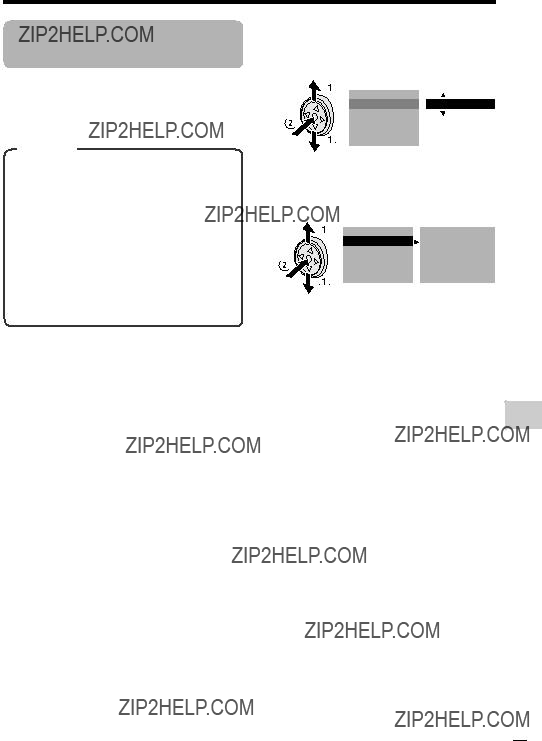
Adjusting White
Balance
The colour of the subject on the screen looks different depending on lighting conditions. Selecting a White Balance setting that matches the lighting conditions.
Types
AUTO: Colouring adjusted automati- cally for the current lighting condition.
LOCK MODE: Fix the setting to the standard balance (White Balance Lock).
OUTDOOR: For recording outdoors on a sunny day.
INDOOR: For recording indoors with halogen lamps or incandescent lighting.
3 Press l or m to select ???WHITE BAL.???, then press the centre of the Operation button.
F U L L A U T O
WH I T E B A L .  A U T O
A U T O
I R I S
G A I N
S H U T . S P E E D
R E T U RN
4 Press l or m to select a white balance setting, then press the centre of the Operation button.
F U L L A U T O E X E C U T E
???When selecting ???LOCK MODE???, perform the steps in ???Locking??? on the next page.
Selecting
1 In Camera mode, press the DISPLAY/ MODE SET button until the mode screen appears.
2 Press l or m on the Operation button to select ???MANUAL SET???, then press the centre of the Operation button (see page 48).
5 Press the DISPLAY/MODE SET button to turn off the MANUAL SET screen.
Features Advanced
(Continued on the next page) 49 

Advanced Features
Camera Recording
Advanced Features
Locking
1 Select ???LOCK MODE??? in step 4 in ???Selecting??? on the previous page.
2 Aim the lens at a white object.
???Adjust the distance of the object so that the entire screen is white.
White paper or white cloth
3 Press the centre of the Operation button to set the white balance lock.
??????LOCK MODE??? will change to ???LOCK??? after pressing the centre of the Operation button.
??????LOCK??? flashes during the locking procedure, and stops flashing after locking the white balance.
Note:
???If you move the camcorder while ???LOCK??? is flashing, ???LOCK??? may not stop flashing. If this occurs, repeat step 3.
4 Press the DISPLAY/MODE SET button to turn off the MANUAL SET screen.
To return to Auto White Balance mode
Press j in step 4 in ???Selecting??? on the previous page or step 3 in ???Locking??? to display ???AUTO???.
To return to Full Auto mode
Set the camcorder to Full Auto mode (see page 54).
Note:
???White Balance setting cannot be used when a scene setting is selected.

 50
50

Manual Iris
The camcorder is preset to Auto Iris mode, which automatically selects the optimal aperture. However, when there is too much contrast in brightness between the subject and background, you may not be able to record a clear image. In this case, use the manual iris function to correct the iris value.
Background is too bright and subject too dark (backlit subject).
???Decrease the iris value to allow more light through the lens.
Subject is too bright against background.
???Increase the iris value to allow less light through the lens.
1 In Camera mode, press the DISPLAY/ MODE SET button until the mode screen appears.
2 Press l or m on the Operation button to select ???MANUAL SET???, then press the centre of the Operation button (see page 48).
3 Press l or m to select ???IRIS???, then press the centre of the Operation button.
4 Press l or m to select the desired iris value, then press the centre of the
Operation button.
F U L L A U T O E X E C U T E
???The number shown is the selected iris value. The adjustment range is 15 steps from F1.8 (most light) to F19 (least light).
5 Press the DISPLAY/MODE SET button to turn off the MANUAL SET screen.
To return to Auto Iris mode
Press j in step 4 above to display ???AUTO???.
To return to Full Auto mode
Set the camcorder to Full Auto mode (see page 54).
Note:
???Manual Iris mode cannot be used when a scene setting is selected.
Features Advanced
51 


Advanced Features
Camera Recording
Manual Gain
When recording in a dark or poorly illuminated location with Auto Gain mode, the light sensitivity of the camcorder (gain) will be automatically adjusted and the recorded image may be brighter than the subject actually is. If you want to faithfully record a dark scene in this case, use the manual gain function. You can also adjust the gain to record a backlit subject brighter.
Example of use
Faithfully recording a dark scene
???Select a smaller gain value (to decrease the light sensitivity).
Background is too bright and subject is too dark (backlit subject)
3 Press l or m to select ???GAIN???, then press the centre of the Operation button.
S H U T . S P E E D
R E T U RN
4 Press l or m to select the desired gain value, then press the centre of the Operation button.
F U L L A U T O E X E C U T E
WH I T E B A L . A U T O
S H U T . S P E E D A U T O
R E T U RN
Features
???Select a larger gain value (to increase the light sensitivity).
1 In Camera mode, press the DISPLAY/ MODE SET button until the mode screen appears.
2 Press l or m on the Operation button to select ???MANUAL SET???, then press the centre of the Operation button (see page 48).
???The number shown is the selected gain value. The adjustment range is 7 steps from 0dB (lowest sensitivity) to L18dB (highest sensitivity).
Note: If you select a large gain value, the image may appear grainy.
5 Press the DISPLAY/MODE SET button to turn off the MANUAL SET screen.
Advanced
To return to Auto Gain mode
Press j in step 4 above to display ???AUTO???.
To return to Full Auto mode
Set the camcorder to Full Auto mode (see page 54).
Note:
???Manual Gain mode cannot be used when a scene setting is selected.

 52
52

Setting the Shutter
Speed
The shutter speed is preset to auto mode, which automatically selects the optimal shutter speed for the ambient light. However, depending on the subject or situation, you may want to set the shutter speed manually to create a
1 In Camera mode, press the DISPLAY/ MODE SET button until the mode screen appears.
2 Press l or m on the Operation button to select ???MANUAL SET???, then press the centre of the Operation button (see page 48).
3 Press l or m to select ???SHUT.SPEED???, then press the centre of the Operation button.
I R I S
G A I N
S H U T . S P E E D A U T O
A U T O
R E T U RN
4 Press l or m to select the desired shutter speed, then press the centre of the Operation button.
F U L L A U T O E X E C U T E
???In Camera mode, you can select 18 speeds from 1/12 sec. (???1/12???) to 1/ 10,000 sec. (???1/10000???).
5 Press the DISPLAY/MODE SET button to turn off the MANUAL SET screen.
To return to Auto Shutter Speed mode
Press j in step 4 above to display ???AUTO???.
To return to Full Auto mode
Set the camcorder to Full Auto mode (see page 54).
Recommended Shutter
Speeds
The faster the shutter speed, the darker the picture becomes. Select the most appropri- ate shutter speed for the ambient light.
(Continued on the next page) 53 

Advanced Features
Camera Recording
Advanced Features
Tips on Using the Manual Shutter Speed
???Fast shutter speeds can be used with the still recording functions (see page 35) to record higher quality still images of
???If the
Notes:
???Recording with a shutter speed faster than 1/50 sec. tends to darken the picture. Record in bright locations when you use a fast shutter speed.
???Using a fast shutter speed under fluorescent lighting will cause flickering in the picture and possibly periodic colour shifts.
???When selecting 1/25 sec. or 1/12 sec. shutter speed, you may get a shadow image behind a subject that is moving around a lot.
???The Manual Shutter Speed setting cannot be used when a scene setting is selected or the e indicator appears.
???The shutter speed will be set to AUTO when selecting ???ON e??? in
Tips on Manual
Settings
When the mode or menu screen is off, press and hold down the centre of the Operation button until the screen shown as below appears. You can set focus, white balance, iris, gain and shutter speed manually.
F U L L A U T O E X E C U T E
S H U T . S P E E D A U T O
R E T U RN
Setting the Camcorder to Full Auto Mode
You can set all the settings shown in the screen to Full Auto mode in one operation.
1 In Camera mode, press the DISPLAY/ MODE SET button until the mode screen appears.
2 Press l or mon the Operation button to select ???MANUAL SET???, then press the centre of the Operation button (see page 48).
F U L L A U T O  E X E C U T E
E X E C U T E
WH I T E B A L . L O C K
S H U T . S P E E D 1 / 5 0 0
R E T U RN
3 Press l or mto select ???FULL AUTO???, then press the centre of the Operation button.
F U L L A U T O  E X E C U T E
E X E C U T E
WH I T E B A L .
I R I S
G A I N
S H U T . S P E E D
R E T U RN
4 Press l or mto select ???EXECUTE???, then press the centre of the Operation button.
F U L L A U T O E X E C U T E
WH I T E B A L .  A U T O
A U T O
I R I SA U T O
G A I NA U T O
S H U T . S P E E D A U T O
R E T U RN
5 Press the DISPLAY/MODE SET button to turn off the MANUAL SET screen.
Note:
???You cannot select ???FULL AUTO??? when no manual settings are currently in use.

 54
54

Scene Menu
(Program AE)
You can set the camcorder to a shooting mode that will create the best results for a specific situation. Just select one of the six scene settings shown below. The camcorder will automatically set the exposure, white balance, and shutter speed to produce the optimum picture quality for the selected situation.
Types
SPORT (A): When you want to record a
DUSK (B): When you want to faithfully record the red of the setting sun, and the surrounding twilight.
SUNLIGHT (F): When background is very bright.
PARTY (C): When the illumination is from a spotlight or candle.
NIGHT LUMI (D): When you want to record fireworks or an illuminated object in the dark.
SLOW SHUT. (E): When you want to record an object in a dim place and make it emerge brightly.
1 In Camera mode, press the DISPLAY/ MODE SET button until the mode screen appears.
2 Press l or m on the Operation button to select ???SCENE MENU???, then press the centre of the Operation button.
A U T O F O C U S
B L C / G A I N
F A D E
S C E N E ME N U O F F
3 Press l or m to select the scene setting that best fits the recording situation, then press the centre of the Operation button.
???The selected scene setting displays on the mode screen.
SC E NE MENU DU S K
4 Press the DISPLAY/MODE SET button to turn off the mode screen.
???The selected scene setting indicator displays when the
P A U S E
Scene setting indicator
To cancel the scene setting
Select ???OFF??? in step 3 above.
Note:
???Scene settings cannot be used when using any manual setting except focus. Also not selectable when e displays.
Features Advanced
55 


Advanced Features
Camera Recording
Advanced Features
Digital Picture
Effects
These digital picture effects let you record the subject with a more dramatic effect.
Types
B/W: To record in
SEPIA: To record in sepia colour similar to that of an old photograph.
SOLARI: To record with enhanced contrast, creating an unique artistic image.
NEGA: To record a picture whose blacks and whites of the image are reversed and colours of the image are inverted.
1 In Camera mode, press the DISPLAY/ MODE SET button until the mode screen appears.
2 Press l or m on the Operation button to select ???PIC.EFFECT???, then press the centre of the Operation button.
B L C / G A I N
F A D E
S C E N E M E N U
P I C . E F F E C T O F F
O F F
3 Press l or m to select the desired digital picture effect, then press the centre of the Operation button.
P I C. E F F E C T B
B W
W
4 Press the DISPLAY/MODE SET button to turn off the mode screen.
To cancel the digital picture effect
Select ???OFF??? in step 3 above.
Note:
???Digital picture effects will not work when a still image is displayed.

 56
56
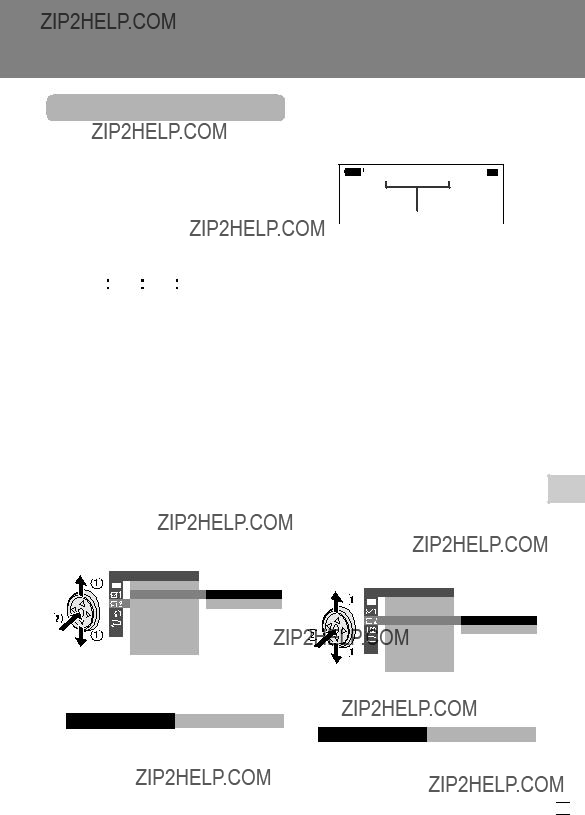
Advanced Features
Playback
Using the Time Code 5 Press the MENU button to turn off the menu screen.
The time code shows the hour, minute and second of recording, and the frame number (1 frame = approx. 1/25 sec.). This is automatically recorded along with the subject when you are recording on the tape. You can display the time code on the screen as an accurate counter in both Playback and Camera modes.
???The time code appears when the on- screen indicators are turned on.
T C 0 : 1 0 : 2 0
AUDIO1 + 2
Time code
Display format
???The example screens shown are for Playback mode.
1 During playback or camera recording, press the MENU button to display the menu screen.
2 Press l or m on the Operation button to select ~, then press the centre of the Operation button.
3 Press l or m to select ???TIME CODE???, then press the centre of the Operation button.
S E T T I NG
R E T UR N
4 Press l or m to select ???ON???, then press the centre of the Operation button.
T I ME CODE ON
To turn off the time code
Select ???OFF??? in step 4 above.
Notes:
???When the tape reaches an unrecorded section, the time code returns to zero (TC 0:00:00). Once recorded, the time code cannot be changed.
???You can also press the T/C button on the remote control (not supplied) to display the time code.
Displaying the time code on a TV during playback
1 In Playback mode, press the MENU button to display the menu screen.
2 Press l or m on the Operation button to select ~, then press the centre of the Operation button.
3 Press l or m to select ???TC OUT???, then press the centre of the Opera- tion button.
S E T T I NG
R E T UR N
4 Press l or m to select ???ON???, then press the centre of the Operation button.
5 Press the MENU button to turn off the menu screen.
Features Advanced
57 

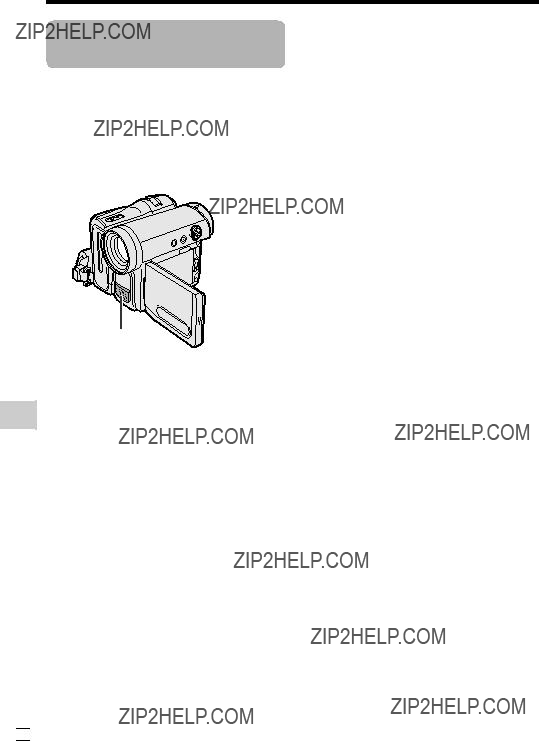
Advanced Features
Playback
Advanced Features
Audio Dubbing
Feature
You can add narration to recordings made with this camcorder, while preserving the original audio and video recordings.
Microphone for Audio Dubbing
You can use the
Note:
???You cannot use audio dubbing with recordings made in LP mode.
Audio Recording
In normal recording mode
The audio is recorded in monaural on Audio 1.
Audio 1: Monaural sound
Audio 2: No audio
The audio is recorded in monaural on two separate channels.
Audio 1: Monaural sound
Audio 2: Monaural sound
In Audio Dubbing mode
The dubbed audio is recorded on Audio 2.
Audio 1: Original monaural sound
Audio 2: Dubbed monaural sound
The dubbed audio is recorded on Audio 2 over the original monaural sound.
Audio 1: Original monaural sound
Audio 2: Dubbed monaural sound
Notes:
???You can select the
???You can perform audio dubbing, such as music, on Audio 2 if you connect another source via the AV cable. If the audio to be dubbed was recorded in

 58
58

Audio Dubbing
1 Play back the Mini DV cassette recorded in SP mode and locate the tape position where you wish to start audio dubbing.
2
3
4 Press l or m to select ???AUDIO DUB???, then press the centre of the Operation button.
??? The audio dubbing screen appears.
P I C . E F F E C T
A U D I O D U B  E X E C U T E
E X E C U T E
S T R E T C H P B
T C 0 : 0 0 : 0 0
AUDIO1 + 2
A U D I O DU B
 S T A R T
S T A R T  S T O P
S T O P  C A N C E L
C A N C E L
5 Press m to begin audio dubbing. Record your narration.
To pause audio dubbing
Press l. To resume audio dubbing, press m again.
To cancel audio dubbing
Press the centre of the Operation button in step 4. The audio dubbing screen disap- pears.
If you wish to change the dubbed audio or dub addi- tional scenes
1 Press the DISPLAY/MODE SET button to turn off the audio dubbing screen.
2 Repeat steps 1 to 5 above.
Notes:
???It is recommended that you use Audio Dubbing only with recordings made with this camcorder. Use of recordings made with other digital video equipment may result in poor audio quality.
???Audio dubbing will automatically pause if the original audio changes from
???Audio dubbing will automatically stop if a portion recorded in LP mode or an unre- corded portion of the tape is encountered.
???You can play back the dubbed audio and the original audio together or separately (see page 60).
??????AUDIO DUB??? cannot be selected when the Mini DV cassette is recorded in LP mode.
Features Advanced
59 


Advanced Features
Playback
Selecting the Audio
Playback Mode
You can select any of the following audio playback modes.
Audio 1H2
3
4
Press l or m on the Operation button to select V, then press the centre of the Operation button.
Press l or m to select ???AUDIO???, then press the centre of the Operation button.
???
???
Audio 1
???
???
Audio 2
???
???
Note:
???This camcorder can output stereo sound when a tape is recorded in stereo.
1 Playback a Mini DV cassette with dubbed audio.
2 Press the MENU button to display the menu screen.
*???ANLGyDGTL??? does not appear with
5 Press l or m to select the desired audio playback mode, then press the centre of the Operation button.
6 Press the MENU button to turn off the menu screen.
???The selected audio playback mode indicator only appears when the on- screen indicators are turned on.
Advanced Features
AUDIO1 + 2
Audio playback mode indicator
Note:
???The audio playback mode indicator, ???AUDIO???, displays in different colours depending on the recording mode (12- or 16- bit) used for the recording being played back. A white display indicates

 60
60

Editing
Video editing lets you refine your videos by removing unwanted sequences from your tape, or transposing one sequence with another.
This camcorder lets you monitor the source program on the
Preparation
Connect the camcorder to a VCR with the supplied
Recording (VCR)
VIDEO
Black: To

 Yellow: To video input jack
Yellow: To video input jack
 White: To audio input (L) jack
White: To audio input (L) jack
Red: To audio input (R) jack

Playback
To AV terminal
 : The arrow shows the signal flow.
: The arrow shows the signal flow.
Notes:
???See page 2 for how to open the terminal cover.
???If your VCR has only one audio input jack, use the white plug for the audio connection on the VCR.
???If your VCR has an
Cutting Unwanted Se- quences
1 Play back the tape to be edited on the camcorder, and locate the beginning and end of the sequence you wish to cut. Write down the time code reading at the beginning and end of that sequence (see page 57). Then, rewind the tape to before the beginning of the portion that you wish to keep.
2 Load a video cassette into the recording VCR.
3 Press m on the camcorder to begin playback, then press the Record button on the VCR to begin recording.
4 Press the Pause/Still button on the VCR to pause recording when the source tape reaches the beginning of the sequence to be cut.
5 Press the Pause/Still (or Record) button on the VCR to resume recording when the source tape reaches the end of the sequence to be cut.
To stop editing
Press l on the camcorder and press the Stop button on the VCR.
Notes:
???Some of the transitions between edited sequences may be slightly off.
???There may be picture noise during video search or still playback. This does not imply a defect in the camcorder.
???The time code display will be recorded along with the edited sequences if the TC OUT menu item is set to ???ON???. Set to ???OFF??? before editing (see page 57).
Features Advanced
61 


Advanced Features
Playback
Recording from an External Source
You can use this camcorder to record or edit videos from another source, such as a VCR or TV.
Preparation
Connect the camcorder to the source equipment with the supplied audio/video/S- video cable, as shown.
Playback (VCR or TV)
Notes:
???This function cannot be used with VL- Z100.
???See page 2 for how to open the terminal cover.
???If the source equipment has only one audio output jack, use the white plug for the audio connection on the source equipment. (The input audio will only be recorded on the left channel of the tape.)
???Even if the source equipment has an
VIDEO
Black: To
Yellow: To video output jack
White: To audio output (L) jack
Red: To audio output (R) jack
Advanced Features

Recording
To AV terminal
 : The arrow shows the signal flow.
: The arrow shows the signal flow.

 62
62

To Record from an External Source
1 In Playback mode, press the MENU button to display the menu screen.
2 Press l or m on the Operation button to select Z, then press the centre of the Operation button.
3 Press l or m to select
O T H E R S 1
D E F A U L T
 R EMO T E
R EMO T E
B E E P
S - V I D E O I N O F F
Notes:
???To pause recording, press m. Press m again to resume recording.
???To operate by remote control (not supplied), perform steps 1 to 6 above, and press the TAPE REC START/STOP button, then press the PLAY/STILL button (g).
???If a digital video recording with a copyright protection signal is used as the playback source, ???COPYRIGHT PROTECTED.??? appears on the camcorder monitor and the recording function is disabled.
4 Press l or m to select ???ON??? (for S- video connection) or ???OFF??? (for video connection), then press the centre of the Operation button.
5 Press the MENU button to turn off the menu screen.
???
6 Begin playback on the source equipment connected to the camcorder.
???Check the camcorder screen to see if the picture is properly received.
7 Press the Record Start/Stop button on the camcorder, then press m to begin recording.
Features Advanced
63 


Advanced Features
Playback
Editing with the DV Terminal (IEEE1394)
This camcorder can be used as a digital video editor. A DV cable transfers all dubbing signals including video and audio directly to the camcorder.
Preparation
To Record to Video Equip- ment
See ???Cutting Unwanted Sequences??? on page 61 using the video equipment as the recording source.
Note:
???Make sure that the video equipment to which you are recording can input dubbing signals via the DV terminal.
Connect the camcorder to video equipment with a DV terminal using a commercially available DV cable.
Advanced Features
 DV cable (commercially available)
DV cable (commercially available)
To DV terminal
Note:
???See page 2 for how to open the terminal cover.

 64
64

To Record from Video Equip- ment
1 Set the camcorder to Playback mode, and insert a Mini DV cassette.
2 Begin playback on the video equip- ment connected to the camcorder.
???Check the camcorder screen to see if the picture is properly received.
3 Press the Record Start/Stop button on the camcorder.
???The camcorder enters Recording Standby mode.
4 Press m on the Operation button to begin recording.
To stop recording
Press l on the Operation button.
Cutting Unwanted Sequences
1 Press m to pause recording when the source tape reaches the beginning of the sequence to be cut.
2 Press m to resume recording when the source tape reaches the end of the sequence to be cut.
Notes:
???Make sure that the video equipment from which you are recording can output dubbing signals via the DV terminal.
???If the video equipment is not set to playback mode or the DV cable is not properly connected, ???NO SIGNAL??? is displayed on the camcorder screen.
???If no picture or sound is input to the camcorder even if the DV cable is properly connected and you are playing back the source media from the video equipment, set the Power switch on the camcorder to OFF and then back to w, or disconnect the DV cable and connect it again.
???If a digital video recording with a copyright protection signal is used as the playback source, ???COPYRIGHT PROTECTED.??? appears on the camcorder monitor and the recording function is disabled.
???When displaying the playback picture on the PC, you may find black bands around the image. This is caused by the differences of the image display sizes.
??????i.LINK??? refers to the
Features Advanced
65 

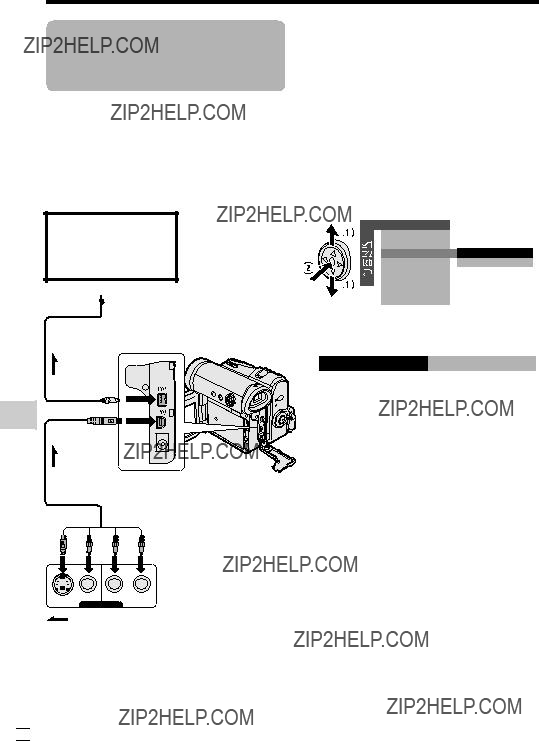
Advanced Features
Playback
Using the Camcorder as a Converter
You can use this camcorder to convert from analog signal (e.g. video recorded on 8 mm or Hi8 tapes) to digital signal.
Preparation
Connect the
Recording (digital equipment)
e.g. computer
 To DV terminal
To DV terminal
1 Set the camcorder to Playback mode, and make sure that playback is stopped.
2 Press the MENU button to display the menu screen.
3
4 Press l or m to select ???ANLGyDGTL???, then press the centre of the Operation button.
P L A Y B A C K S E T
 R O T A T E P B
R O T A T E P B
A U D I O
A N L G D G T L O F F
D G T L O F F
R E T U RN O N
5 Press l or m to select ???ON???, then
 DV cable (commercially available)press the centre of the Operation button.
DV cable (commercially available)press the centre of the Operation button.
Features
Digital signal
To DV terminal
To AV terminal
Analog signal
A N L G D G T L O N
D G T L O N
Press the MENU button to turn off the menu screen.
Press the Play button on the analog equipment.
???Check the monitor on the digital equipment to see if the picture is being properly received.
Advanced

Black: To
Yellow: To video output jack
White: To audio output (L) jack
Red: To audio output (R) jack
Playback
(analog equipment) e.g. 8 mm or Hi8 camcorder
: The arrow shows the signal flow.
Note:
???See page 2 for how to open the terminal cover.
8 Press the Record button on the digital equipment.
Notes:
???This function cannot be used with VL- Z100.
???The camcorder is not guaranteed to work with all digital/analog equipment. Contact the manufacturer of your equipment for advice.
???If the camcorder outputs a video recording with a copyright signal, the digital equipment cannot record or save it.
???The camcorder may not convert some input video recordings properly (e.g. discolouration, picture noise, muted sound), depending on the input condition.

 66
66

Appendix
Picture/Backlight
Adjustments
If the picture is difficult to see due to ambient light or other factors, adjust the monitor picture settings.
???The example screens shown are for Camera mode.
5 Press the MENU button to turn off the menu screen.
Note:
???When adjusting the colour, the picture on the LCD monitor may differ from the picture actually recorded. Do not change the colour setting unless necessary. (This adjustment only affects the monitor picture, not the recorded image.)
Adjusting the Picture
1
2 Press l or m on the Operation button to select O, then press the centre of the Operation button.
L C D S E T
BA CKL I GHT NORMAL
 R E T U RN
R E T U RN
*???VF BRIGHT??? does not appear with
3 Press l or m to select ???LCD BRIGHT???, ???LCD COLOUR??? or ???VF BRIGHT???, then press the centre of the Operation button.
???The viewfinder turns on if you select ???VF BRIGHT???
4 Press j or k to adjust the item to the desired setting, then press the centre of the Operation button.
*???VF BRIGHT??? does not appear with
Adjusting the Backlight
1 Press the MENU button to display the menu screen.
2 Press l or m on the Operation button to select O, then press the centre of the Operation button.
3 Press l or m to select ???BACK- LIGHT???, then press the centre of the Operation button.
L C D S E T
B A C K L I G H T N O RMA L
L C D B R I G H T B R I G H T
L C D C O L O U R
 * V F B R I G H T
* V F B R I G H T
R E T U RN
*???VF BRIGHT??? does not appear with
4 Press l or m to select ???NORMAL??? or ???BRIGHT???, then press the centre of the Operation button.
B ACKL I GHT BR I GH T
67
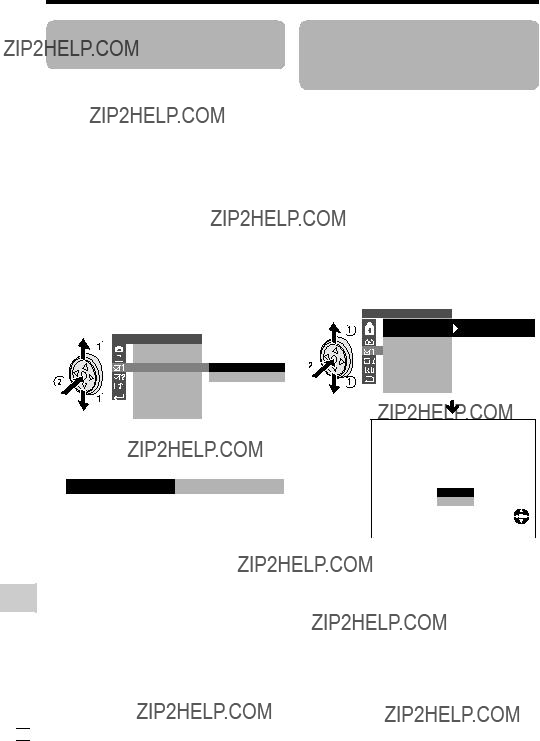
Appendix
Appendix
Turning off the Confirmation Sound
A confirmation sound is made when you turn on or off the Power switch, press the Record Start/Stop button, or perform other designated operations. Use the procedure below to turn off the confirmation sounds.
???The example screens shown are for Camera mode.
1
2 Press l or m on the Operation button to select Z, then press the centre of the Operation button.
3 Press l or m to select ???BEEP???, then press the centre of the Operation button.
R E T U RN
4 Press l or m to select ???OFF???, then press the centre of the Operation button.
5 Press the MENU button to turn off the menu screen.
To turn on the confirmation sound
Select ???ON??? in step 4 above.
Setting the Camcorder to Factory Presettings
You can set the camcorder to the factory presettings in one operation.
???The example screens shown are for Camera mode.
1 Press the MENU button to display the menu screen.
2 Press l or m on the Operation button to select Z, then press the centre of the Operation button.
3 Press l or m to select ???DEFAULT???, then press the centre of the Operation button.
D E F A U L T
R E T U R N T O P R E S E T T I N G S
E X C E P T C E R T A I N I T EMS .
NO
Y E S
 S E L E C T
S E L E C T  S E T
S E T
4 Press l or m to select ???YES???, then press the centre of the Operation button.
??? To cancel the setting, select ???NO???.
5 Press the MENU button to turn off the menu screen.
Note:
???Even when you perform the steps above, the clock setting will remain in the camcorder???s memory.

 68
68

Demonstration Mode
You can watch a brief demonstration of the special camcorder features in Demo mode. If the demonstration appears on the screen when you turn on the camcorder for the first time, cancel the Demo mode to use your camcorder.
Watching
1
2
3 Press l or m on the Operation button to select Z, then press the centre of the Operation button.
4 Press l or m to select ???DEMO MODE???, then press the centre of the Operation button.
5 Press l or m to select ???ON???, then press the centre of the Operation button.
DEMO MODE ON
6 Set the Power switch to OFF, then hold down the Lock button and set the Power switch to v.
??? The demonstration begins.
Cancelling
1 During the demonstration, press the centre of the Operation button to pause the demonstration.
2 Perform step 2 to 4 in ???Watching???, then select ???OFF??? in step 5.
Notes:
???The demonstration will pause if you press the centre of the Operation button. If you leave it for 60 seconds, or turn the power off temporarily and then set the Power switch to v, the demonstration will begin again.
???Demonstration mode does not work in self recording with reversed grip.
Appendix
69 


Appendix
Useful Information
Hints for Better Shooting
???Position the subject in the centre of the scene. When using auto focus, whatever is in the centre of the scene is kept in focus.
???Horizontal panning (lateral movement) and tilting (vertical movement) should be done slowly to emphasize the wide expanse of a scene or the height of a building, and to make scenes easy to watch during playback.
???Use a
Note:
???It may take longer to focus when zooming and panning are used frequently.
???Avoid backlit subjects. For the best picture, shoot with the light source behind you.
When the background is brighter than the subject, the subject often becomes too dark. If you have to record in this lighting, use Backlight Compensation or correct the iris value to improve the picture (see pages 31 and 51).
Appendix
???Before zooming, think about how to best frame the shot. Frequent zooming produces unattractive pictures. It also runs down the battery more quickly.
???When image shaking is noticeable during

 70
70

Mini DV Cassette
Precautions when using a Mini DV cassette
???Be sure to use only Mini DV cassettes with the imark.
???This camcorder can record and play back using Mini DV cassettes with cassette memory, but it cannot record or play back this memory.
???To record in LP mode, use a Mini DV cassette labelled for use with LP mode.
???Do not insert anything into the holes on the bottom of the Mini DV cassette or block them in any way.
???Avoid placing the Mini DV cassette in areas conducive to dust or mold.
???Do not place the Mini DV cassette near magnetic sources such as electric clocks or magnetic devices as this may adversely affect recorded material.
???When a previously recorded Mini DV cassette is used again for recording, the previously recorded material will be automatically erased.
???The Mini DV cassette will not operate if inserted in the wrong direction.
???Do not repeatedly insert and eject the Mini DV cassette without running the tape as this may cause uneven tape winding and damage the tape.
???Do not place the Mini DV cassette in direct sunlight, near strong heat sources, or in areas with excessive steam.
???Store the Mini DV cassette in its case and stand it in an upright position.
???If the tape is not properly wound, rewind the tape.
???Do not drop the Mini DV cassette or subject it to excessive shocks.
To protect recordings against accidental erasure
Slide the protect tab on the rear of the Mini DV cassette to the ???SAVE??? position.


 Erasure protect tab
Erasure protect tab
To record over a previously recorded tape, slide the protect tab to the ???REC??? position.
About a tape recorded with high- definition camcorder
This camcorder cannot play back a tape recorded with
Appendix
71

Appendix
Appendix
Battery Pack
This camcorder uses a
Charging
???Charge the battery pack immediately (or a day) before use. The battery pack gradually
???Charge the battery pack between 10??C and 30??C.
???Fully charge the battery pack. Use of an insufficiently charged battery pack will shorten actual time of use.
???Refresh (discharging before charging) is unnecessary.
Use
???To conserve battery power, be sure to turn off the camcorder power when not in use.
???Battery consumption may vary depending on the condition of use. Recording with many starts and stops, frequent zooming, and recording in low temperatures will shorten actual recording times.
???Use of a weak battery pack may cause loss of power while operating the camcorder. Use a fully charged battery pack to protect both the battery pack and the unit.
???It is recommended that you have enough battery packs on hand to handle two or three times your estimated recording time. See page 20 for the approximate times of actual recording for the battery packs.
Battery power is consumed even when the camcorder power is turned off. If you are not going to use your camcorder immediately, remove the battery pack (see page 6).
Note:
???Use only SHARP
Storage
???Store the battery pack in a fully dis- charged state.
???Store the battery pack in a dry, cool place.
???When storing the battery pack, put it in the original protective plastic bag.
Notes:
???Improper handling of the battery pack may present a risk of fire or explosion. Pay close attention to the following:
???Do not allow metallic objects to come in contact with the terminals. This can cause a short circuit.
???Do not attempt to disassemble or repair the battery pack.
???Do not use any battery charging equipment other than that designed for use with these battery packs.
???Do not place the battery pack under direct sunlight or in excessively hot places (over 60??C) such as the dashboard of cars.
???Do not expose the battery pack to moisture or water.
???Do not drop the battery pack or subject it to strong force.
???Keep the battery pack out of reach of children.
???Dispose of used battery packs promptly. Do not dispose of them in fire.
???To protect the terminals, put the cover on the battery pack when it is not in use.
???The battery pack will become warm during charging and use. This is not a malfunction.
???The battery pack has a limited service life. If the period of use becomes noticeably shorter with a normal charge, the battery pack is at the end of its service life. Replace it with a new battery pack.
???If the terminals of the battery pack are dirty, wipe the terminals with a soft, dry cloth.

 72
72

Even when the battery pack is not used, the capacity of the battery pack will naturally deteriorate over time. To limit the deteriora- tion of the capacity, it is recommended to perform the following procedure at least once every six months:
1Charge the battery pack until the POWER/CHARGE (RED) indicator turns off.
2Attach the battery pack to the camcorder, and set the Power switch to v without inserting a cassette and turn off the power save mode. Allow the battery power to fully discharge by leaving it on the camcorder until the camcorder power automatically turns off.
3Remove the battery pack and store it between 10??C and 20??C.
???Many plastic parts are used in the camcorder casing. Do not use thinner, benzene or other strong chemical cleaners. These may cause discolouration and damage to the casing.
???Clean the casing with a soft, dry cloth. If the casing is particularly dirty, wipe the casing with a tightly wrung cloth damp- ened with a diluted, neutral detergent. Then wipe it again with a soft, dry cloth.
???Use a soft cloth to wipe finger marks and other smudges off the LCD screen.
???Use a soft cloth, or compressed air and lens paper designed for photographic lenses to clean the lens.
???Pull out the viewfinder and open the window cleaning cover as shown below so that you can clean up the inside of the viewfinder with a camera blower.
AC Adapter
???The AC adapter may interfere with reception if used near a radio.
???Prevent flammables, liquids, and metal objects from entering the adapter.
???The adapter is a sealed unit. Do not attempt to open or modify it.
???Do not damage, drop, or subject the adapter to vibration.
???Do not leave the adapter in direct sunlight.
???Avoid using the adapter in humid or extremely hot places.
Replacing the Fluorescent
Lamp
This camcorder uses a fluorescent lamp to backlight the LCD monitor. If the monitor becomes dark or difficult to view, the fluorescent lamp may need to be replaced. Contact the nearest SHARP service centre or your dealer for further advice.
Window cleaning cover
Note:
???After cleaning, close the window cleaning cover securely. Closing the viewfinder with the window cleaning cover opened may cause malfunction.
Appendix
73 


Appendix
Using Your Camcorder
Abroad
Television signal standards and electrical voltages and frequencies vary substantially from country to country. When you are abroad, check the sections below before using the AC adapter or connecting the camcorder to a TV.
AC Adapter (Supplied Accessory)
The supplied AC adapter is compatible with 50 Hz and 60 Hz electrical systems in the range of 110 V to 240 V AC.
Television Signal Standards
In any country, you can always watch the video picture by using the LCD monitor screen. However, if you want to watch the picture on a TV screen, the TV must be PAL system compatible. PAL is used in the following areas:
Germany, United Kingdom, Ireland, Sweden, Denmark, Austria, Belgium, Switzerland, Italy, Spain, Holland, Finland, Portugal, Norway, Hong Kong, Thailand, Australia, New Zealand, Singapore, Kuwait, China, etc.
Copyright Protection
The digital VCR has far superior recording and playback ability than the traditional analog VCR, and in order to protect digital video software copyrights, a system for managing copyrights has been established. Some digital video recording with prere- corded copyright protection signals can still be played back on this camcorder. If you play a digital video recording that has a copyright protection signal on video equipment with a DV terminal and attempt to record a copy of that software on this camcorder, ???COPYRIGHT PROTECTED.??? appears on the screen and the recording is disabled.
This product incorporates copyright protection technology that is protected by method claims of certain U.S. patents and other intellectual property rights owned by Macrovision Corporation and other rights owners. Use of this copyright protection technology must be autho- rized by Macrovision Corporation, and is intended for home and other limited viewing uses only unless otherwise authorized by Macrovision Corporation. Reverse engineering or disassembly is prohibited.
Appendix

 74
74

Troubleshooting
Before calling for service, please check the following troubleshooting table.
Power
Camera mode
Appendix
75 


Appendix
Playback mode
Appendix

 76
76

General
Appendix
77 


Appendix
General
Notes:
???This unit is equipped with a microprocessor. Its performance could be adversely affected by external electrical noise or interference. If this should happen, turn off the power and disconnect the unit from any power sources, including the lithium battery, etc. Then reconnect the power sources to resume operation.
???If the characters displayed in the viewfinder or on the LCD monitor screen appear to malfunc- tion, disconnect the power source and remove the lithium battery, then reconnect the power source, insert the lithium battery, and turn the power on again. The characters on the monitor should be normal. Set the date and time, then resume operation.
Appendix

 78
78

Specifications
Camcorder
Specifications are subject to change without notice.
*Minimum illumination: Since there is no widely accepted testing procedure for determining minimum illumination capability, lux ratings are comparable only between models from the same manufacturer.
Appendix
79 


Appendix
Appendix

 80
80

Playback mode
*
???ANLGyDGTL???,
BRIGHT??? do not appear with
Appendix
81 


Appendix
Appendix

 82
82

Appendix
83 


Note

SHARP CORPORATION